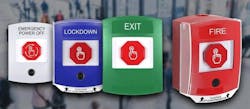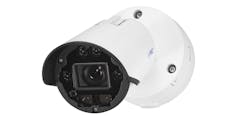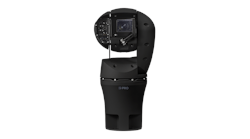Avoid Callbacks By Choosing The Right Access Control Components
One of my accounts, a nursing home, asked me to “please come over ASAP to address an issue with a door.” I was able to determine the problem was with a standalone mechanical-type keypad on a door to a utility room within the Alzheimer’s ward which occupied the third floor of the facility.
This is an important customer. It is an older building and has door problems on a regular basis. They are also subject to numerous code authorities who regularly inspect the premises and point out violations.
About two years ago the local authority having jurisdiction (LAHJ) issued my customers several pages of violations and an ultimatum that if the violations were not addressed, they’d be closed down in 90 days.
That list of violations related to how they were controlling emergency exits. The nursing home) fought it because they had never been faced with such an exhaustive list of issues despite the fact that they had been there for several years and were regularly audited. They had issues about endangering the patients by potentially allowing them to escape the building; they kept the facility in relatively good repair, and the punch list would require about $30,000 to address.
I was able keep them open.
The outcomes of that experience are that we kept a valued customer and that customer has implemented a daily functional test of all the emergency exit doors and equipment.
Their electronic access control equipment includes mechanical keypads, several delayed egress systems, keypad and remotely controlled electromagnetic locks, monitored only stairwell doors, local visual and audible annunciators, and central nurse’s station panels where door status is monitored and alarm conditions can be acknowledged. Of course they also have the usual intercoms and telephones, patient monitors, wander guards, smoke doors, etc. There are beeps and signals constantly going off when you are in this place.
When I installed my system, I avoided adding to this noise pollution by using voice commands telling the nurses the location and nature of the alarm rather than just blast a siren. The LAHJ was impressed.
This is an older building, and things seem to change from day to day, either because of wear and tear to the hardware, electronic failures or deliberate/consequential abuse.
You need to give healthcare providers a lot of credit for functioning under a situation where there are no positive outcomes. There is no cure for old age. The best they can hope for is to make their clients comfortable.
Some of the damage we repair is the cause of carelessness and misuse, not just natural causes. I can think of closer arms ripped out of door frames.
Damage also results when a component was not correctly rated for the application, was poorly designed or manufactured, or was improperly installed.
When you get a call to fix something you provided and installed, it may be a callback. If you get called to fix something someone else provided or installed, it is usually a paid service call. A goal is to get paid every time you roll the truck.
The mission of the professional locksmith is to provide a quality product, properly rated for the application, and install it according to the manufacturer’s instructions appropriate to the prevailing site conditions.
What this means is that if the door or frame is in some way damaged, you may not be able to do a simple bolt in with the standard hardware kit supplied with the product. You may have to perform some field engineering.
That is a partial explanation for why I drive a rolling warehouse of tools, components and parts. (The other reasons are I hate to throw anything out, and I never seem to have time to perform vehicle hygiene).
Specifying the appropriate product for a project is essential, but as we all know, customers will often dispute you on what to specify, sometimes predisposed to a particular product. Most often, their objection will be based on cost.
We’ve all been faced with the same situation in our own purchasing decisions. You look for advice, try to fall back on experience, or simply do the math.
Lessons Learned
My client has learned from experience a few important lessons.
Lesson 1. I will always be there for them when they need me. Some way some how, I will cover them when an emergency develops. Dealing quickly with a situation is a good way to avoid a service issue evolving into a crisis.
Lesson 2. I will treat them fairly. I will offer them alternative solutions and advise of the trade offs associated with each alternative.
Sometimes regrettably, one of the alternatives is for them to obtain a part directly from a wholesaler or on-line. The fact is the web is full of people selling equipment for less than my cost.
This customer is part of a national franchise of similar facilities, and they have national accounts with catalog distributors who carry everything for a facility, including locks and door hardware. The guys at the top want to take away the individual location facility manager’s prerogatives. The facility manager must operate within budget, and possibly have to explain the expenditure.
Lesson 3. I will professionally install the hardware and honor the warranty, an important differentiator in today’s competitive market.
Most of the warranties offered these days are factory warranties, which means the manufacturer will deal with a bad product once it is returned to them in the factory.
Some manufacturers require you obtain a Return authorization before returning the item. Some require that you are the original purchaser or installer of the product and you can provide an invoice number.
Some manufacturers will provide an advanced warranty replacement which is helpful to get the door into service and avoid an awkward situation where there is nothing on the door while materials are in transit.
No warranty covers the time and labor required to go to a site and remove and reinstall the product, so I always emphasize to the customer that although a product has a warranty, there will be a labor and handling charge associated with honoring the warranty. I also commit to being there for them and handle it expeditiously if the need does arise.
That’s my job. I try to standardize on products which have earned my respect because of that magic balance which determines a good value; a recipe which combines cost, features, support and reliably. That’s the same formula clients use to measure me as a commodity.
You may have to route your returns through a distributor or you may be able to deal with the manufacturer directly. Some manufacturers require that a dealer have a factory account in order to do this, which means you are doing adequate volume of sales for them to open you an account.
Details such as these are what build loyalty with dealers, and consequently build brand recognition and value among end-users.
Some vendors have built up their brand and keep customers with a good product and robust customer service, while others have killed their brand name and have lost out by treating customers poorly.
Service Call
On this particular day, the door was one I had not previously worked on, and I had been servicing this account for more than five years. The item which had failed was a Simplex 5021XSW-26D.
This is a five-button mechanical standalone storeroom function keypad lever with a SC-1 override key in brushed chrome. I didn’t install it or sell it to the customer.
When I arrived, my customer showed me an in-swinging solid wood door in a metal frame with plaster ceilings and sheetrock or plaster walls. The lever was hanging at 5 o’clock, and there was no “Enter” button, just a hole where one had been.
The customer also reported that he could not find the key.
The room was used by “housekeeping” and they had grown accustomed to depressing the hole where the Enter button used to be, but when the lever spring broke, it caused problems.
At first I thought we were locked out of the room and I psychologically prepared for battle with the door, but then the customer demonstrated how he could hold the lever in a horizontal position, enter the code, push in on the enter hole and open the door.
I said we’d need to get the lock off the door, and he said we’d relock the door and go back to his office downstairs and retrieve a spare lock he had which he could pop on the door temporarily.
I told him that he must not close the door because there was an excellent chance we would be unable to regain entry and it could be a job to get in. But in this clinical environment, leaving doors such as this open or unlocked without a nurse or other responsible individual supervising is hazardous to the patients.
My customer said it would be a form of recreation to break in the door. I said it would not be any fun for me, and would he just go get another lock and I would guard the opening and remove the faulty lock while he was getting the other lock.
With the door open, removing the Simplex is as simple as unscrewing four screws. Unfortunately the serial number had been scraped off the lock.
Simplex underwent a redesign at a point in time which made it impossible for me to immediately determine which version it was.
Of course when the client had initially called me, I had obtained enough information to determine that it would be smart to bring along a replacement. I do not keep mechanical locks in stock, but I have many electronic standalones and I brought my E-Plex E-5731XSWL-626 which is mounted on a demonstration stand.
As I already mentioned, this facility has many doors which have electronics on them. What is on the door has a lot to do with who was servicing the account when the need arose for access control, what hardware was existing on the door, what functionality was required for the opening, and the budget.
Since we had solved the immediate crisis, I had time to consider options and my customer had time to decide.
I determined that all the parts necessary to fix the old lock were available, but the broken Enter button would necessitate returning the lock to the factory,
I offered my E-Plex at a great price, but my customer was more interested in a mechanical lock.
Even though the code box was still working on the Simplex and the lever spring was no biggie, the rest of the lock looked pretty bad, and the customer said he would just as soon replacing it with another one of the same type, which was a #5021XSW-26D This model is supplied with two keys and a three-year warranty and lists for $498.
I will wait for them to decide. Either way, I charged for that service call and eventually, they’ll need my services once again. And either choice will secure the opening.
While I was there, I serviced a two-station video intercom that had suddenly stopped working. It was an Aiphone Mk1GD master station which had failed.
As I walk through the facility, my customer he is constantly intercepted with requests to clear a clogged toilets or figure out why air conditioning was not cold, or fix a broken bed.
They use trouble tickets so he reminds his staff to send in it through appropriate channels and he will address it as time permits. He’ll say “Sorry I don’t take requests any more.” But locksmiths sure do.
Tim O'Leary
Tim O'Leary is a security consultant, trainer and technician who has also been writing articles on all areas of locksmithing & physical security for many years.






